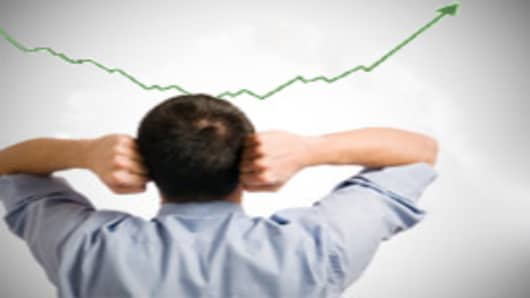Appearances to the contrary, the 13-month runup in stock prices has been absent one critical element—participation from mom-and-pop investors.
Trillions in cash are sitting on the sidelines because investors are still afraid of the market after seeing half the value sucked out of stocks during the financial crisis.
And while pros think retail investors are starting to come back, they see the process as a slow one that will only accelerate when people feel safe again.
"If you go back to 2000, think about how much money was lost, then think about how long it took for retail investors to come back into the market," says Quincy Krosby, general strategist at Prudential Financial.
"The gains in the equity market will compel the retail investors to move from the diminishing returns from bond funds and reallocate" to equities, she adds. "Ultimately the retail investor realizes that the equity market is doing well. They want part of those gains, so they start allocating money."
Indeed, market yardsticks are showing a grudging move off the sidelines as Wall Street strives to surpass the psychological milestone of Dow 11,000.
Money market assets hit $2.964 trillion for the week ended April 7, the Investment Company Institute reported this week. That marks the first time money market accounts have held less than $3 trillion since October 2007, when the financial markets began to implode and set the stage for a calamitous bear market that crested in March 2009. Money market inflows were $14.3 billion for the week, according to Lipper data.
The good news is that the lack of participation from average investors sets up for another leg higher in the market, likely in the staircase fashion that has marked much of the move higher in 2010.
The bad news is that as retail investors finally realize they have missed a large portion of a 75 percent rally in stock prices and start to pile back in, that likely will signal the top of the market.
"We know in the last 10 years or so that when the retail investor moves into an asset class and moves in with force that is very often the beginning of the end of that asset class's gain for that cycle," Krosby says.
Brian Belski, chief investment strategist at Oppenheimer, said in an interview with CNBC this week that the strong flow of Main Street investors into the market will be his signal to get out.
But he doesn't see that point happening anytime soon.
"We as investors are still kind of sitting in the bunker because we're scared of what happened in 2007 and 2008...so we're acting and investing very defensively and not seeing the forest through the trees," Belski said (see video below). "What that's telling us is we're seeing a classic recovery. It has its issues, but we still think we head higher through the year."
Still, advisors remain baffled over the lack of participation and worry whether that in itself could be setting up a correction—usually defined as a 10 percent drop in stocks—that has yet to materialize.
"This could be the most significant, least-satisfying bull market to Wall Street itself in the stock market's history," Rick Bensignor chief market strategist at Execution Noble in New York, said in a note to clients. "[I]t's the biggest party ever that no one showed up to."
Market bears are growing increasingly reluctant about stepping in front of the Wall Street bull.
Short interest on the New York Stock Exchange—often considered a contrarian sign for market direction—is at 14.1 billion shares, ahead of the December 2009 total by 1.1 billion shares but well short of the 2007 mark.
"At this point any of us who have been bearish are just too tired of being wrong that it's hard to stick your neck out," said Kathy Boyle, president of Chapin Hill Advisors in New York.
Boyle sees clients who are still leery of the stock market, and are thus likely only to get back until well after the major gains have been realized.
"How will we know we're at the top? I don't think we're going to until after the fact," she said. "The average person is still disenfranchised. Individual people just got out of the market and they don't have the risk tolerance. They see their future looming. They don't trust the market, they feel it's being manipulated. Bond funds look safe."
Bond investing continues to far outpace stocks.
Equity fund inflows excluding exchange-traded funds were at $1.2 billion, compared to $3.5 billion for bond funds in the week ended April 7, according to Lipper. Both figures represent gains approaching 50 percent from the previous week.
While retail investor participation is only one factor in what determines the broader movement of the market, the trends suggest that hesitance is likely to remain and the market could be looking at more of the same for months to come.
"In terms of the entry of retail investors, it's clear we're early in that cycle," says Lawrence Creatura, equity market strategist and portfolio manager at Federated Clover Capital Advisors in Rochester, N.Y. "Those investors flooded the zone in terms of investing in the bond market."
"The shift from bonds to equities is at its very early stages, because investors are tentative about the economy, the jobs market," he continues. "Out there in the real world, the all-clear sign has not been given."



